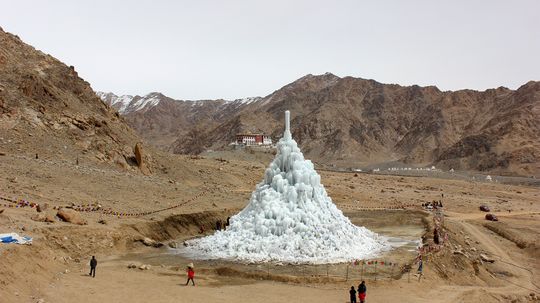In a world where climate change threatens the delicate balance of our ecosystems, innovative solutions are needed to combat its devastating effects. One such solution is the creation of artificial glaciers in the majestic Himalayas, which not only provide much-needed water for local communities but also serve as a testament to human resilience and ingenuity.
A Lifeline in Frozen Form
These remarkable artificial glaciers act as frozen reservoirs, storing water during winter months when it is abundant and releasing it gradually during spring and summer when it is most needed. This ingenious technique ensures that precious water resources are efficiently managed, allowing farmers to irrigate their crops even during dry spells.
The process begins by diverting streams into narrow channels that wind through mountainous terrain. As temperatures drop below freezing point, these channels transform into ice formations known as “ice stupas.” These towering structures resemble Buddhist stupas or pagodas, hence their name. Standing tall against the backdrop of snow-capped peaks, they symbolize hope and perseverance amidst adversity.
An Ancient Tradition Reimagined
While this method may seem like a modern invention born out of necessity, its roots can be traced back centuries ago to traditional farming practices in Ladakh region of India. Farmers would create small ice dams called “chadars” across streams to slow down the flow of water and allow it to freeze naturally during winter months.
Today’s artificial glaciers build upon this ancient wisdom by utilizing modern engineering techniques. By strategically placing conical nets over these channels before freezing occurs, evaporation is minimized while maximizing ice formation. This results in larger ice stupas that can store more water for longer periods.
A Beacon of Hope
These artificial glaciers not only provide a lifeline for local communities but also serve as a symbol of resilience and adaptation in the face of climate change. They demonstrate that even in the harshest environments, human innovation can find ways to thrive.
As we witness the Himalayas being transformed into frozen reservoirs, it is a stark reminder of our responsibility to protect and preserve our planet’s fragile ecosystems. The creation of these artificial glaciers serves as an inspiration for us all to take action against climate change and work towards sustainable solutions that benefit both people and nature.
A Call to Action
The journey towards revitalizing the Himalayas through artificial glaciers is far from over. It requires continued support from governments, organizations, and individuals alike. By investing in research, infrastructure development, and community engagement initiatives, we can ensure that this innovative solution reaches its full potential.
Let us embrace this remarkable feat of human ingenuity as a testament to what can be achieved when we come together with determination and purpose. Together, let us strive towards creating a future where nature thrives alongside humanity – one ice stupa at a time.
